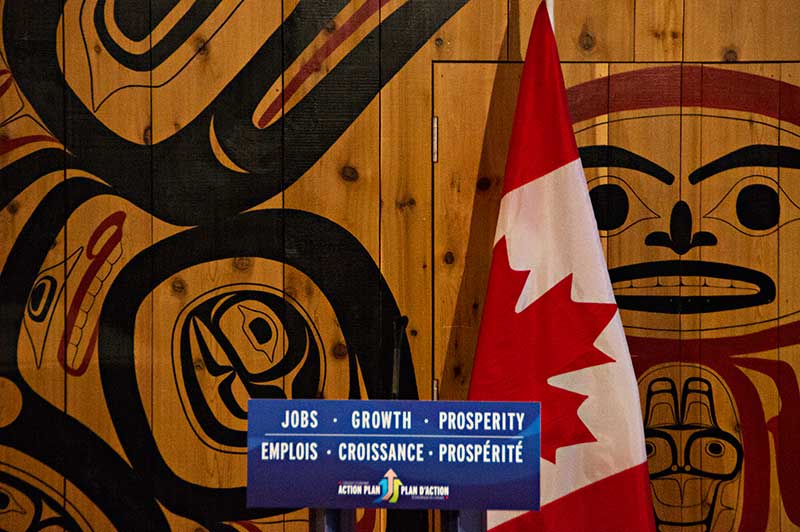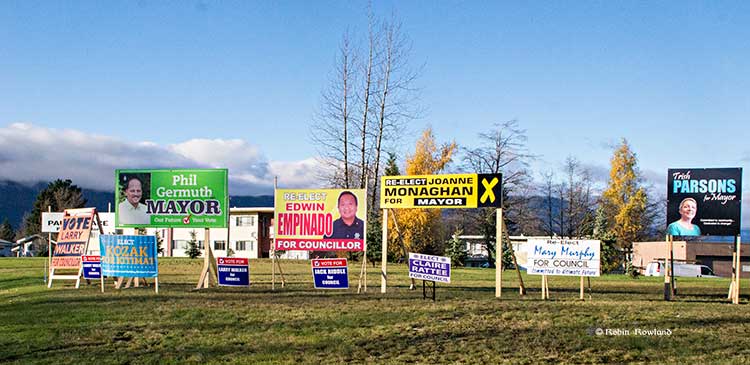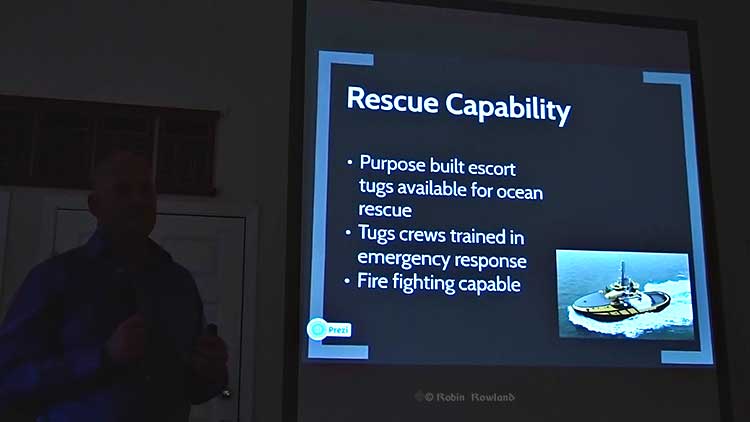
If anyone wanted a snapshot (or for younger folks a selfie) of why the Harper government grounded out at home, never even getting to first base with northwestern British Columbia on Northern Gateway and other resource projects, it can be found in about sixty pages of documents, obtained by Northwest Coast Energy News under the Access to Information Act, documents that outline the planning for former Natural Resources Minister Joe Oliver’s first visit to Terrace in March 2013
- The documents reveal the priority for Natural Resources communications staff was mainly finding an appropriate First Nations visual backdrop for Oliver’s speech announcing the appointment of Douglas Eyford as special representative to First Nations, the Harper government’s attempt to smooth relations as it dawned on the government that opposition to Northern Gateway wasn’t just going to disappear.
- Despite years of media coverage from both those opposed to and even those who support the Northern Gateway project that highest priority issue was preventing oil spills whether from tankers or pipelines, the Ottawa-based communications planners in Natural Resources Canada were talking about how aboriginal and non-aboriginal communities could respond to oil spills.
- For an event that was supposed to engage the First Nations of coastal British Columbia and gain their support for resource projects, all the economic examples are about Alberta First Nations who are working the extraction of bitumen in Alberta, there are no example of how BC First Nations might profit from Northern Gateway (that is if any BC First Nations actually wanted to do so)
- A visit to Kitimat, the centre of the debate, wasn’t even on the radar in March, 2013, as Joe Oliver, then Minister of Natural Resources, even though Kitimat is just a 40 minute drive from the site of the announcement at the Terrace campus of Northwest Community College.
When Natural Resources Canada started planning Joe Oliver’s announcement they created what was called a “Message Event Proposal” which even in its title shows how the government and the communications staff think. The message is more important than the event.

The planning documents from Natural Resources, starting on March 5, 2013, indicate that from the beginning the announcement was being treated as a photo op. Invitations to or participation by “stakeholders” are listed as N/A “not applicable,” which meant that meetings, even private meetings, with representatives of northwestern First Nations and other communities either weren’t considered or the communications staff weren’t informed. (If there were such plans they were not part of the access documents released and as far as Northwest Coast Energy News can find out no meetings took place since Oliver left for Ottawa immediately after the announcement)

The Natural Resources communications staff were working on multiple angles in March, as part of what the planning documents call “a suite of events in Vancouver on marine and pipeline safety.”
The first set of those events would eventually take place on March 18, 2013, in Vancouver, and included the announcement, without consulting either Rio Tinto Alcan or the District, that Kitimat’s private port run by Alcan since it was first built would be turned in a federal public port.
The announcement of Eyford’s appointment would eventually take place at the Waap Galts’ap community long house at Northwest Community College in Terrace on the morning of March 19.
That location certainly wasn’t clear at first. The first documents suggested the announcement take place in Vancouver, and then a day later on March 6, the proposed venue, according to the staff, was in either Prince Rupert or Prince George.
According to the internal e-mails, sometime that week what Ottawa bureaucrats call MINO — the minister’s office– decided that the venue should be Terrace. On March 11, e-mails among Natural Resources staff show that the choice had changed to either Terrace or Prince George.
Since the “special representative” whom we now know would be Douglas Eyford, would report directly to Prime Minister Stephen Harper, the political level was involved. MINO took over writing Oliver’s speech and the arrangements were copied to the Privy Council Office, the civil service branch that has overall supervision of the federal bureaucrats and works directly with the Prime Minister. So the speech that the communications branch had drafted for Oliver became “can please turn the one we had done for him into the remarks for the new guy?”
Plan B in Prince George
The choice of Terrace left the Natural Resources Ottawa staff hedging their bets, looking for a “potential plan B” in Prince George. The e-mails indicate that Ottawa asked Natural Resources west coast communications officer for a list of suitable locations in Prince George.
The communications officer replied with three locations at the University of Northern British Columbia “a moving bear totem on campus” the main administration building which the e-mail said “ has a strong First Nations focus,” adding “Environment Canada has done…events there. Strong FN visuals.” The third choice was “a new bio energy facility that looks industrial.”
Backups were The College of New Caledonia trade centre and the Prince George industrial park.


E-mails from the staff on Wednesday, March 14 and Thursday, March 15, showed while they were now aware the event would be in Terrace, and probably at Northwest Community College, there was still a lot of uncertainty. “We haven’t been able to contact them to confirm, but as soon as we do, we will let you know the exact details as well as what is required in terms of logistics.”
Remembering that Natural Resources and Transport Canada were also planning the Vancouver event on Monday, March 18, it appears that even as Oliver arrived on the morning of March 19, the minister’s staff both political and bureaucratic were still scrambling.
On March 19, the NWCC staff on site were complaining that as soon as the Ottawa delegation saw the standard arrangements for an event at the Waap Galts’ap community long house they ordered the NWCC staff to immediately rearrange the room, so that the podium was in front of one wall with what Oliver’s staff thought was a better First Nations painting. That rearranging was still going on when I arrived to cover the announcement.

Even after the furniture was rearranged, the start was delayed as Oliver and his staff disappeared into an upstairs room for a meeting before the news conference began, and Oliver announced Eyford’s appointment.
During the question and answer session with the media during the news conference, the students that had essentially been brought in as props for the photo op and to help promote Northwest Community College’s industrial training program, began to ask questions.

One student asked Oliver if Eyford’s appointment was going to replace “all talks” with First Nations about resource projects. The Natural Resources public relations staff tried to cut off one student, since the national media were waiting on a telephone conference call. To his credit, Oliver did answer the student’s question, saying Eyford’s appointment was not intended to “replace the independent, regulatory review.” He went on to explain the Northern Gateway Joint Review would continue its work and report at the end of 2013.
What was Ottawa thinking? You too, can respond to an oil spill.
If the aim was to engage the First Nations and other residents of northwestern BC, it is clear that the concerns of this region hadn’t reached out Ottawa.
It appears from the planning documents for Joe Oliver’s trip to Terrace, that a main concern of everyone in the northwest, aboriginal and non-aboriginal, opponents and supporters of the Northern Gateway pipeline, preventing oil spills also wasn’t on the government radar, rather it was preparing and responding to oil spills.
Guess who would respond?
As part of the measures to strengthen Canada’s Marine Oil Spill Preparedness and Response Regime, the Government of Canada will strengthen the engagement and involvement of Aboriginal and non-aboriginal communities in preparing for and responding to oil spills.
When it comes to a key section on benefits from the Northern Gateway and other resource projects, there is no mention of benefits to British Columbia; rather it appears all the examples of benefits for aboriginal communities come from Alberta, including $1.3 billion in contract work for oil sands companies not including construction, for the year 2010, and $5 billion since 2001. The Message Event Proposal also cites a joint venture between the Bigstone Cree and Bronco Energy, “the biggest oil sands project every undertaken on First Nations reserve lands.”
Overall the plan was to “Promote Canada’s commitment to achieving its goals under its plan for Responsible Resource Development, including increased consultations with Aboriginal peoples.”
The “media lines’ issued by Natural Resources also outlined the Harper government’s attitude to the Northern Gateway, noting that Eyford’s appointment was independent of the Northern Gateway Joint Review, and went to indicate that the JRP was “conducting a rigorous, extensive, open, science-based assessment.” It adds that “we will continue to rely on the integrity of this process,” again showing how out of touch Natural Resources was (at least in talking points) since by March 2013, there was growing consensus in the northwest that the JRP had lost its credibility.

The media lines also show that the Harper government believed that “Aboriginal consultations are fully integrated into the review process to ensure meaningful consultation occurs,” a position that most First Nations in British Columbia reject, insisting on meaningful consultations between the Crown and the First Nation.
When Eyford presented his report to the Prime Minister in December, 2013, Eyford called for stronger action to engage First Nations opposed to new oil and gas pipelines.
“It’s never too late to engage and do so in a process of good faith negotiations… “This won’t be an easy process. I hope my report is perceived as providing objective and blunt advice to all the parties engaged in this process.’’
The 53 page report contained dozens of recommendations mainly concerned with a more open and principled dialogue with First Nations.
“The development of West Coast energy infrastructure provides an opportunity to forge partnerships and build relationships. There is a strong interest and real opportunity for Canada and aboriginal Canadians to more effectively collaborate to address their respective interests.’’
Editor’s note: On the port issue, an RTA spokesperson noted that talks with the federal government are continuing. He noted that all the Kitimat port facilities are privately owned, by Rio Tinto Alcan or by LNG Canada and there are “multiple stakeholders” involved.
Documents
Natural Resources Media Lines (pdf)
Natural Resources Message Event Proposal (pdf)
Forging Trust Douglas Eyford’s final report (pdf)
Related Links
Joe Oliver makes flying visit, meets Haisla, snubs Kitimat (almost)













































